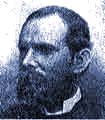|
 James
Hannington was born the son of a merchant on September 3, 1847. His
grandfather, Smith Hannington, was the founder of Hanningtons, Brighton's
leading department store. As a young man he worked in his father's business
until the late 1860s. After receiving a degree from Oxford in 1873, he
was ordained by the Church of England and in 1882 was sent by the Church
Missionary Society to the Lake Victoria region of Africa. James
Hannington was born the son of a merchant on September 3, 1847. His
grandfather, Smith Hannington, was the founder of Hanningtons, Brighton's
leading department store. As a young man he worked in his father's business
until the late 1860s. After receiving a degree from Oxford in 1873, he
was ordained by the Church of England and in 1882 was sent by the Church
Missionary Society to the Lake Victoria region of Africa.
Illness caused him to return to England to recover. In 1884 he was consecrated
the Anglican Bishop of Eastern Equatorial Africa. .
In 1885, after recuperating in England, he tried again, approaching Uganda
from the North East. This proved to be a mistake. Uganda's suspicious
King Mwanga lumped him with the Germans who were grabbing territory in
that direction. He sent a thousand Ugandan soldiers to intercept Hannington.
On October 21, 1885, they took him prisoner. They allowed him a little
freedom at first and he walked out to look at the Nile. His journal tells
what happened next:
". . . suddenly
about twenty ruffians set upon us. They violently threw me to the ground,
and proceeded to strip me of all valuables. Thinking they were robbers
I shouted for help, when they forced me up and hurried me away, as I
thought, to throw me down a precipice close at hand. I shouted again
in spite of one threatening to kill me with a club. Twice I nearly broke
away from them, and then grew faint with struggling and was dragged
by the legs over the ground.
I said, 'Lord, I put myself in Thy hands, I look to Thee alone.' Then
another struggle and I got to my feet and was then dashed along. More
than once I was violently brought into contact with banana trees, some
trying in their haste to force me one way, others the other, and the
exertion and struggling strained me in the most agonizing manner.
In spite of all, and feeling I was being dragged away to be murdered
at a distance, I sang 'Safe in the Arms of Jesus' and laughed at the
very agony of my situation. My clothes were torn to pieces so that I
was exposed; wet through with being dragged on the ground; strained
in every limb, and for a whole hour expecting instant death, hurried
along, dragged, pushed at five miles an hour, until we came to a hut..."
After exhibiting
him as a trophy for a week, his tormentors speared him to death on the
29th.
We know most of this detail because one of the Ugandans kept Hannington's
journal and sold it to a later expedition. Some eight days later he was
led out towards the banks of the Victoria Nile and martyred for the cause
of Christ.
His last words are reported to have been "Tell
the king that I die for Uganda. I have bought this road with my life."
|
